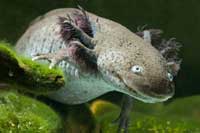They can regrow severed limbs and have gills sticking out of their heads – look no further than the axolotl if you want an oddball amphibian.
The axolotl (pronounced axe-oh-lot-ul) is a neotenic Mexican tiger salamander (Ambystoma mexicanum). “Neotenic” means the salamander did not progress beyond its larval stage. All salamanders and newts start out as embryos in gelatinous eggs, much like frogs, before emerging and progressing through a larval stage. And lucky for you, we have an illustration of the whole process, using the fire-bellied newt as an example, right here. Axolotls, however, don’t progress beyond the larval stage. They enter it and stay put. I suppose they could be considered a prime example of an arrested adolescent.
Because they remain “forever young,” axolotls retain the larval characteristics common in developing salamanders and newts, including the external gills and fins along the tail. The gills are definitely their most striking feature. Axolotls do have rudimentary lungs, but they obtain oxygen through the use of their gills, siphoning it from the water the same way fish do.
Years ago, a childhood friend of mine went to the Colorado River on vacation, and when he returned home he brought me a present. Knowing my fondness for all things herp, he presented me with a bizarre-looking creature. It looked like a big, fat salamander with freaky feathery appendages sticking out from both sides of its head. Apparently, these things were being sold in bait shops on the river at a dirt-cheap price. He called it a “waterdog.” It sounds a lot like an axolotl, doesn’t it? Yet, it was probably a larval-stage tiger salamander, which looks a lot like an axolotl.
Where does “waterdog” come in? According to the website www.axolotl.org, the word is a commonly accepted translation from the Aztec words “atl” (water) and xolotl (dog). Interestingly, according to the same website, Xolotl is also the Aztec god of deformations and death (see photo).
Axolotls may not be encountered as commonly as other herps, but they do have their fan base. If your local reptile store doesn’t have any, try looking in a tropical fish store, where they can sometimes be found due to their completely aquatic nature. Wild axolotls are considered endangered, but because axolotls are used often for medical research, they are bred in captivity regularly. They are used for medical research because of their ability to regenerate lost limbs. Other salamanders can do this, but axolotls are apparently very good at it! Read a short article about some recent medical research that is utilizing axolotls here.
Keeping pet axolotls isn’t particularly difficult. They don’t need a land area, just water. Use a filter to keep their water clean, unless you’re really into frequent complete water changes, because axolotls are pretty messy. Even with a filter, water changes will be necessary, both partial and occasional complete changes. Filter media will need to be cleaned and/or replaced, too. Axolotls usually do OK in room-temperature water in the high 50s to mid 60s Fahrenheit. Aquarium heaters can be used to maintain the water temperature, and the type that allow you to set the temperature are great. Keep track of temps by using a water thermometer. Water that’s too warm can lead to axolotl stress and illness. Be wary of keeping your axolotl aquarium in a room that can heat up drastically during hot days.
A 20-gallon aquarium could house a couple of axolotls. Ground space is more important than height. Water depth can be as deep as you want it, whether several inches or to the point that the aquarium is practically full. Axolotls don’t typically spend a lot of time swimming, though. They prefer to walk around and sit on the bottom. Remember, too, that deeper tanks are more work when it comes to cleaning them out. Water depth needs to be at least deep enough to cover the axolotls, with a few inches to spare. As for substrate, don’t use regular aquarium gravel, because axolotls may swallow it. Don’t use anything that you think they may be able to swallow. They have big mouths, too, so don’t underestimate their ability to do this. Larger pebbles and marbles can sometimes work, or small river stones. Or don’t use anything, which is often the easiest when it comes to cleaning, even if a bare-bottomed tank doesn’t look very pretty.
Just as landlubber reptiles need hiding places to feel secure, so do axolotls appreciate underwater hiding areas. These can be supplied by pieces of PVC pipe or decorative caves, hollow logs, artificial or live plants and other decorative items that are commonly available at pet supply stores.
Axolotls will eat various worms, such as earthworms, blackworms and bloodworms, as well as frozen brine shrimp and Daphnia. Aquatic turtle and fish pellets can be offered, too; sinking types of foods may be more readily accepted than floating foods. Beef heart, too, is often fed to axolotls, and it is available in frozen cube form in some fish and pet stores.
These are just some bare-bones axolotl care tips. The previously mentioned website has lots more, and I recommend you visit it if you are considering keeping this unique amphibian.






